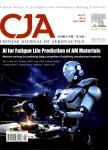Optimization of structural parameters for elliptical cross-section spiral equal-channel extrusion dies based on grey theory
Optimization of structural parameters for elliptical cross-section spiral equal-channel extrusion dies based on grey theory作者机构:State Key Laboratory of Solidification Processing Northwestern Polytechnical University Department of Mechanical Engineering Tsinghua University
出 版 物:《Chinese Journal of Aeronautics》 (中国航空学报(英文版))
年 卷 期:2013年第26卷第1期
页 面:209-216页
核心收录:
学科分类:080503[工学-材料加工工程] 08[工学] 0805[工学-材料科学与工程(可授工学、理学学位)] 0802[工学-机械工程] 080201[工学-机械制造及其自动化]
基 金:co-supported by National Natural Science Foundation of China (No. 51275414) Aeronautical Science Foundation of China (No. 2011ZE53059) National Defense Basic Research Program (No. 51318040105) Graduate Starting Seed Fund of Northwestern Polytechnical University(No. Z2011006)
主 题:Correlation degree Elliptical cross-section spiral equal-channel extrusion (ECSEE) Grey theory Optimization Orthogonal design Simulation
摘 要:The elliptical cross-section spiral equal-channel extrusion (ECSEE) process is simulated by using Deform-3D finite element software. The ratio m of major-axis to minor-axis length for ellipse-cross-section, the torsion angle u, the round-ellipse cross-section transitional channel L1, the elliptical rotation cross-section transitional channel L2 and the ellipse-round cross-section transitional channel L3 are destined for the extrusion process parameters. The average effective strain eave on cross-section of blank, the deformation uniformity coefficient a and the value of maximum damage dmax are chosen to be the optimize indexes, and the virtual orthogonal experiment of L16 (45) is designed. The correlation degree of the process factors affecting eave, a and dmax is analyzed by the numerical simulation results using the weights and grey association model. The process parameters are optimized by introducing the grey situation decision theory and the ECSEE optimal combination of process parameters is obtained: u of 120 , m of 1.55, L1 of 7 mm, L2 of 10 mm, and L3 of 10 mm. Simulation and experimental results show that the material can be refined with the optimized structural parameters of die. Therefore, the optimization results are satisfactory.



